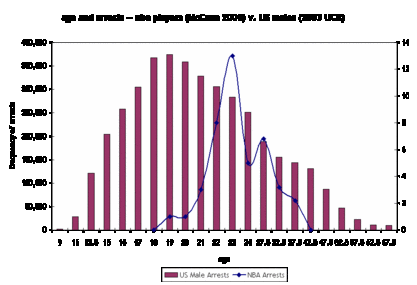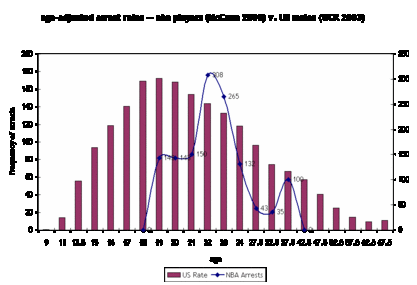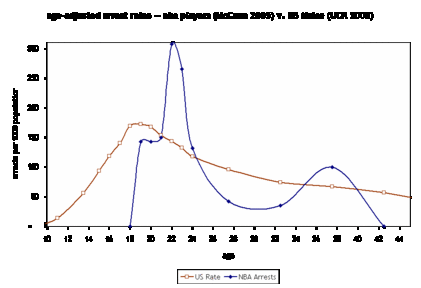First, let's plot the raw number of arrests by age group. I tossed out the retired players (we can hardly blame the NBA for them, can we?) and grouped the arrests by age, FBI-style. I then plotted the curves on two separate y-axes for easy comparison. Just click on the graphs to bring up the full-size versions.
 By the time they get to the NBA, most players are already past their peak offending years. Still, the NBA peak comes relatively early: 23 versus 19 for US men overall. This made me think about age and selection into pro ball. Sadly, there are a lot more 23-year-olds than 41- year-olds in the NBA these days. So what we really need are age-adjusted rates. Here's what happens when we standardize by the number of players in each age group (using 2003 roster data).
By the time they get to the NBA, most players are already past their peak offending years. Still, the NBA peak comes relatively early: 23 versus 19 for US men overall. This made me think about age and selection into pro ball. Sadly, there are a lot more 23-year-olds than 41- year-olds in the NBA these days. So what we really need are age-adjusted rates. Here's what happens when we standardize by the number of players in each age group (using 2003 roster data).

The age-adjusted rate shows the mid-career blip that McCann mentioned. Even without the retirees, older players do get arrested (e.g., Gary Payton's recent DUI). Moreover, McCann seems to be spot-on about the comparatively clean records of 18, 19, and 20 year-olds in the NBA . Still the first two figures are somewhat misleading, since the x-axis shows single years for 16 to 24 but 5-year increments thereafter and the NBA arrests are plotted on a different scale than the US male arrests. So, here's what the age-adjusted arrest curve looks like for NBA players versus the rest of us.
 No wonder coaches keep a close eye on their 23- and 24-year-olds. This is the only piece of the distribution where ballplayers are more likely to get arrested than regular Joes. Why? I'm thinking that off-court activities of 18-year-olds center around in-room Playstation. By the early twenties, however, wealthy young athletes probably venture out of the team hotel a bit more. So, the data are a bit sparse, but I think there's enough here to draw two conclusions: (1) the age-crime curve applies to the NBA as elsewhere (it might not be invariant, but ...); and, (2) McCann seems well-justified in challenging the NBA's age floor for 18-19 year-olds.
No wonder coaches keep a close eye on their 23- and 24-year-olds. This is the only piece of the distribution where ballplayers are more likely to get arrested than regular Joes. Why? I'm thinking that off-court activities of 18-year-olds center around in-room Playstation. By the early twenties, however, wealthy young athletes probably venture out of the team hotel a bit more. So, the data are a bit sparse, but I think there's enough here to draw two conclusions: (1) the age-crime curve applies to the NBA as elsewhere (it might not be invariant, but ...); and, (2) McCann seems well-justified in challenging the NBA's age floor for 18-19 year-olds.
